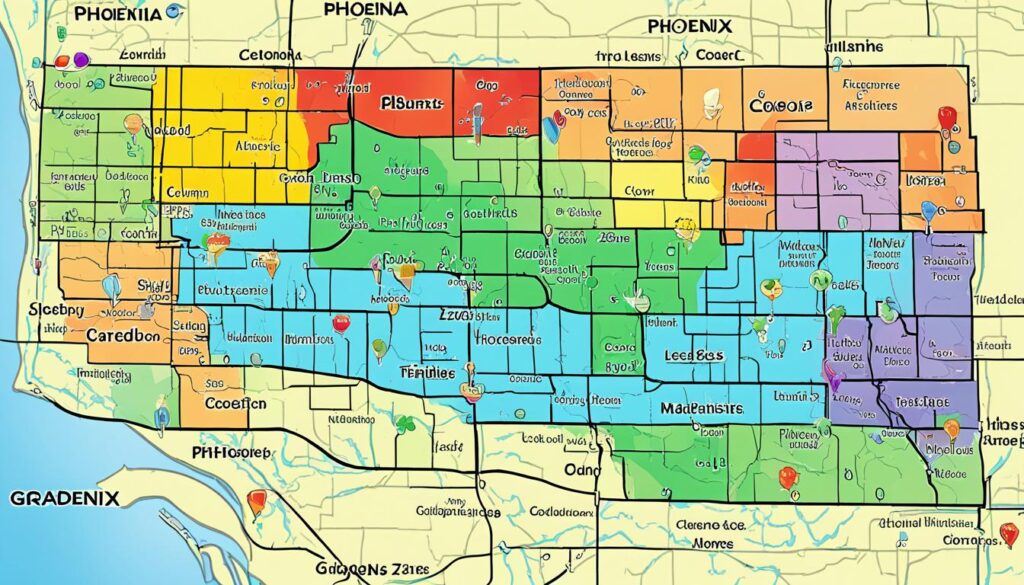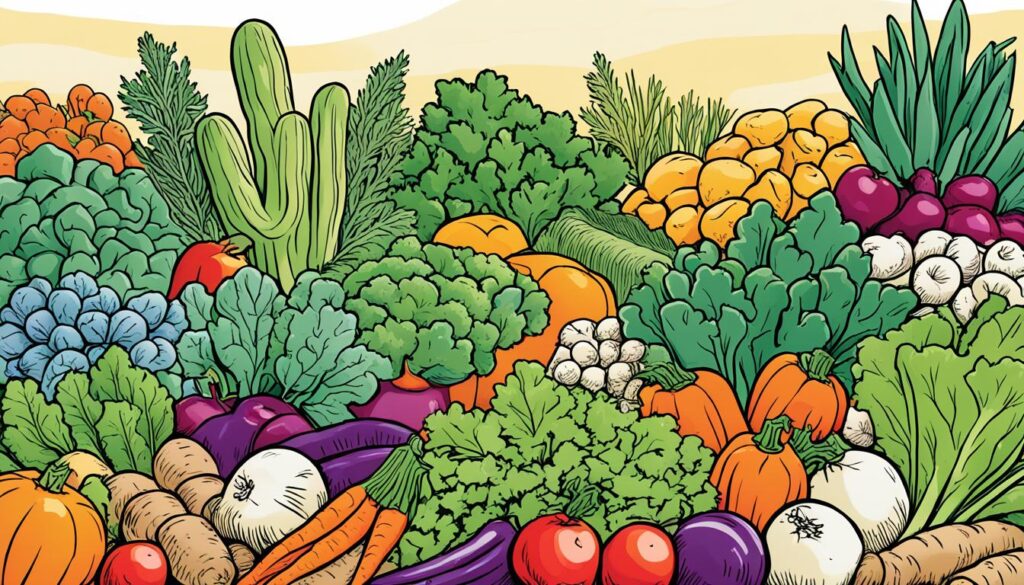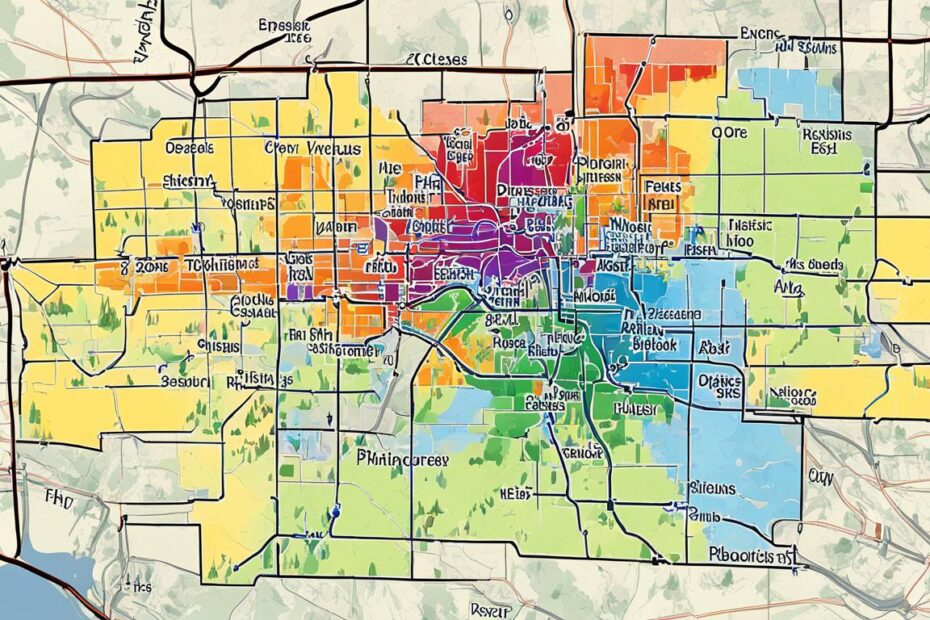Have you ever wondered what the ideal hardiness zone is for gardening in Phoenix, Arizona? Is there one specific zone that ensures successful plant growth in this unique desert climate? Well, get ready to discover the truth and unlock the secrets to a thriving garden in Phoenix!
- Gardening in Phoenix, Arizona requires careful consideration of the city’s hot desert climate and unique environmental challenges.
- Understanding the concept of hardiness zones and their importance is crucial for selecting the right plants for your garden.
- Phoenix is in USDA gardening zone 9b, Sunset Zone 13, and Plant Heat Zone 11. But what do these zones mean?
- Choosing the best plants for Phoenix gardens is essential for ensuring their survival in the extreme temperatures and minimal rainfall.
- Implementing landscaping strategies like raised beds and mulching can greatly enhance the success of your garden in Phoenix.
Curious to learn more about hardiness zones, gardening tips, and the best plants for Phoenix gardens? Keep reading to uncover valuable insights that will help you transform your garden into an oasis in the desert!
Understanding Hardiness Zones and Their Importance
Hardiness zones are determined by the USDA plant hardiness map and indicate the average minimum winter temperature in a specific area. They play a crucial role in gardening, helping you choose plants that can thrive in your climate. By understanding the hardiness zone of your region, you can select plants that are more likely to withstand the local conditions. Different plants have different temperature requirements, and planting them in the appropriate hardiness zone increases their chances of survival and success.
In addition to the USDA plant hardiness map, there are other gardening zone maps that can provide further guidance. For example, the Sunset Climate Zone map takes into account additional factors like geographical location, elevation, frost dates, and humidity levels to determine where specific plants thrive best throughout the year. Similarly, the Plant Heat Zone map evaluates the average number of days with temperatures exceeding 86 degrees Fahrenheit to identify plant heat tolerance. By consulting these complementary maps alongside the USDA plant hardiness map, you can make even more informed decisions about your gardening choices.
Understanding and utilizing the hardiness zones and gardening zone maps ensures that you can create a garden filled with plants that not only survive but thrive in your local climate. Whether you’re an experienced gardener or just starting out, knowing your hardiness zone and the specific needs of the plants you want to grow will provide a solid foundation for a successful garden.
The USDA Plant Hardiness Map
| Hardiness Zone | Winter Temperature Range (°F) |
|---|---|
| 1a | -60 to -55 |
| 1b | -55 to -50 |
| 2a | -50 to -45 |
| 2b | -45 to -40 |
| 3a | -40 to -35 |
| 3b | -35 to -30 |
| 4a | -30 to -25 |
| 4b | -25 to -20 |
| 5a | -20 to -15 |
| 5b | -15 to -10 |
| 6a | -10 to -5 |
| 6b | -5 to 0 |
| 7a | 0 to 5 |
| 7b | 5 to 10 |
| 8a | 10 to 15 |
| 8b | 15 to 20 |
| 9a | 20 to 25 |
| 9b | 25 to 30 |
| 10a | 30 to 35 |
| 10b | 35 to 40 |
Gardening Zone Maps for Phoenix
When it comes to gardening in Phoenix, understanding the different gardening zone maps can be a game-changer. These maps provide valuable information about the specific climate and conditions in the area, helping you choose plants that are well-suited to thrive in your garden.
USDA Gardening Zone
The USDA gardening zone map is a widely used resource for determining the cold hardiness of plants. It classifies areas into different zones based on the average minimum winter temperature. In the case of Phoenix, it falls under USDA gardening zone 9b. This means that the average minimum winter temperature in Phoenix ranges from 25°F to 30°F.
Sunset Zone
The Sunset Climate Zone map takes into account various factors, including geographical location, elevation, frost dates, and humidity levels, to determine where plants will thrive year-round. Phoenix is categorized under Sunset Zone 13, which indicates the specific environmental conditions that plants in this zone can tolerate.
Plant Heat Zone
The Plant Heat Zone map is particularly relevant in Phoenix’s hot desert climate. It measures the average number of days per year with temperatures exceeding 86 degrees Fahrenheit. According to this map, Phoenix is in Plant Heat Zone 11, indicating the heat tolerance level required for plants to flourish in this area.
By considering these gardening zone maps, you can gain a better understanding of the unique climate in Phoenix and select plants that are well-adapted to thrive in the local conditions.
| Gardening Zone | Description |
|---|---|
| USDA Gardening Zone | 9b |
| Sunset Zone | 13 |
| Plant Heat Zone | 11 |

Best Plants for Phoenix Gardens
When gardening in Phoenix, it’s important to choose plants that can withstand the hot desert climate and drought-like conditions. Selecting the right plants will ensure a vibrant and thriving garden that can withstand the challenges posed by the arid environment. Here are some of the best plants for Phoenix gardens:
1. Snake Plant
The Snake plant, also known as Sansevieria, is a hardy plant that can tolerate low water and humidity levels. It thrives in the heat and is perfect for Phoenix gardens. With its tall, upright leaves, the Snake plant adds a striking vertical element to any landscape.
2. Decorative Grasses
Add texture and movement to your garden with decorative grasses. These plants are well-suited to the desert environment and require minimal water. They can add a soft and graceful touch to your landscape design. Popular choices include Mexican Feather Grass (Nassella tenuissima) and Pink Muhly Grass (Muhlenbergia capillaris).
3. Succulents
Succulents are a staple in Phoenix gardens due to their water-saving abilities and stunning architectural forms. The Saguaro cactus (Carnegiea gigantea) and Ocotillo (Fouquieria splendens) are iconic succulents that can withstand the harsh desert conditions while adding a unique beauty to your garden.
4. Native Plants
Opting for native plants in your Phoenix garden not only ensures they are well-adapted to the local climate but also supports the local ecosystem. Native plants provide food and shelter for local wildlife, such as butterflies and bees. Consider incorporating Desert Fairy Duster (Calliandra eriophylla) and White Desert Plumbago (Plumbago scandens) into your garden.
5. Dwarf Schefflera Umbrella Tree
The Dwarf Schefflera Umbrella Tree (Schefflera arboricola) is a compact plant that can add a tropical touch to your Phoenix garden. While it requires a little extra care compared to some other plants, its lush foliage and ability to thrive in a variety of light conditions make it a popular choice for landscape designers.
6. Croton Petra
If you’re looking to add a splash of color to your garden, consider the Croton Petra (Codiaeum variegatum). This tropical plant showcases vibrant foliage in shades of red, orange, and yellow. With proper care, it can thrive in Phoenix’s climate and bring a tropical ambiance to your outdoor space.
By choosing these plants for your Phoenix garden, you’ll be able to create a stunning landscape that thrives in the desert climate. Keep in mind the specific watering requirements and sunlight needs of each plant to ensure their continued health and growth.
| Plant | Key Features |
|---|---|
| Snake Plant (Sansevieria) | Tolerates low water and humidity levels; adds vertical interest |
| Decorative Grasses | Texture and movement; low water requirements |
| Succulents | Water-saving abilities; unique architectural forms |
| Native Plants | Adapted to local climate; supports local wildlife |
| Dwarf Schefflera Umbrella Tree | Compact tropical plant; lush foliage |
| Croton Petra | Vibrant foliage; adds color to the garden |
Landscaping Tips for Phoenix Gardens
To create a flourishing garden in Phoenix, it’s important to consider the unique challenges of the environment. Here are some landscaping tips to help you achieve success:
1. Drip Irrigation Systems
Drip irrigation systems are a must-have for Phoenix gardens. They provide a steady supply of water directly to the roots, minimizing evaporation and ensuring efficient water usage. This is particularly helpful during dry spells when water conservation is crucial. By keeping the soil consistently moist, drip irrigation systems promote healthy plant growth and minimize water waste.
2. Mulching
Mulching is a key technique for maintaining moisture in the soil and reducing water evaporation. Applying a layer of organic mulch around plants helps retain water, suppresses weed growth, and moderates soil temperature. It also improves soil structure and reduces the need for frequent watering. Opt for organic materials like wood chips or straw that break down slowly and add nutrients to the soil over time.
3. Raised Beds
Raised beds offer several advantages for gardening in Phoenix. They allow for better control over soil conditions, including temperature and moisture levels. The elevated height provides better drainage, preventing waterlogging during heavy rains. Additionally, raised beds warm up faster in the spring, extending the growing season. When constructing raised beds, consider using materials like recycled lumber or stone for durability and sustainability.
4. Shade and Sun Protection
Phoenix’s intense sun can be challenging for plants, especially during the scorching summer months. Protect your plants from sunburn and heat stress by providing adequate shade. Use shade cloths or strategically place plants under natural shade, such as near buildings or trees. This helps reduce water loss and keeps plants cooler, ensuring they thrive in the desert heat.
| Landscaping Tips for Phoenix Gardens | |
|---|---|
| Drip Irrigation Systems | |
| Mulching | |
| Raised Beds | |
| Shade and Sun Protection |
Implementing these landscaping tips in your Phoenix garden will help ensure the success of your plants and create a beautiful outdoor space to enjoy year-round.
Planting and Growing Seasons in Phoenix
Phoenix, located in Arizona, offers a year-round planting zone and a generous nine-month growing season, making it a paradise for gardeners. The city’s climate provides favorable conditions for a wide range of plant varieties. However, it’s essential to be aware of the frost dates and winter temperatures to ensure successful gardening in this arid region.
The first frost in Phoenix typically occurs around mid-December. To give your plants a head start, it’s advisable to start seedlings indoors 6-8 weeks before the last frost date. This allows them to establish strong roots and be ready for transplantation once the frost subsides. By taking advantage of this technique, you can extend your growing season and enjoy vibrant blooms and bountiful harvests.
Winter gardens thrive exceptionally well in Phoenix. With milder temperatures, it’s the perfect time to cultivate cold-hardy crops that can withstand the cooler months. Consider adding flavorful Sweet Potatoes, spicy Peppers, and nutritious Turnips to your garden during this time. By embracing the winter season, you can savor a variety of homegrown produce even in the desert.
To protect your plants from the harsh summer conditions, it’s important to implement effective gardening practices. Mulching is an excellent technique that retains soil moisture and regulates soil temperature, keeping your plants healthy and hydrated. Additionally, the use of drip irrigation systems ensures consistent watering while minimizing water waste, critical in a region with scorching summers and arid conditions.
| Recommended Winter Crops for Phoenix | Optimal Planting Time |
|---|---|
| Sweet Potatoes | October – November |
| Peppers | October – November |
| Turnips | November – December |
By selecting crops that are well-suited to the Phoenix climate and implementing appropriate strategies to protect them, you can enjoy a thriving garden throughout the year. Embrace the unique growing seasons in Phoenix, and let your green thumb flourish in this desert oasis!
CHECK OUR RECOMMENDED PRODUCTSPlanting in Zones 9b & 10a
When it comes to planting in Phoenix, you have the advantage of being in USDA Hardiness Zones 9b and 10a. These zones correspond to minimum average winter temperatures of 25°F to 30°F and 30°F to 35°F, respectively. These zones provide valuable guidance for selecting and growing crops that are well-suited to the climate of Phoenix.
If you are planting in Zone 9b, some excellent choices for winter crops include Sweet Potatoes, Black Eyed Peas, Peppers, and Pecan Trees. These plants have the resilience and adaptability to thrive in the colder temperatures of Zone 9b.
In Zone 10a, you can continue to enjoy a wide variety of crops during the winter months. Consider planting hearty vegetables like Broccoli, Cabbage, Cauliflower, and Lettuce. These crops have the ability to withstand the milder temperatures of Zone 10a and will provide a bountiful harvest.

“In Zone 9b and 10a, you have the opportunity to cultivate an array of winter crops that will thrive in the mild climate of Phoenix. From leafy greens to nutrient-rich vegetables, these crops will not only add beauty to your garden but also provide a fresh and delicious harvest.”
When planting in Zones 9b and 10a, it’s essential to create optimal growing conditions for your crops. Consider implementing mulching techniques to retain moisture and regulate soil temperature. Adequate watering is also crucial to ensure the healthy development of your plants. By providing the right care and attention, your winter crops in Phoenix will flourish and yield abundant rewards.
Conclusion
Summing up, gardening in Phoenix, Arizona requires careful consideration of the city’s hot desert climate and unique environmental challenges. Understanding the hardiness zones is essential for selecting plants that can withstand the specific conditions of Phoenix’s climate. By choosing appropriate plants and implementing gardening techniques like mulching and drip irrigation, you can create a successful garden that thrives in this arid region.
Whether you opt for native plants or decide to experiment with non-native varieties, taking the time to research and plan according to your area’s specific conditions is crucial. This will allow you to achieve vibrant growth and gardening success in your Phoenix garden.
Remember to pay attention to the hardiness zone, select plants that are suitable for your specific zone, and implement appropriate gardening techniques to ensure the health and vitality of your plants. With the right knowledge and care, your Phoenix garden can flourish despite the challenging climate.
FAQ
What does hardiness zone mean and why is it important for gardening?
Hardiness zones indicate the average minimum winter temperature in a specific area. They help gardeners determine which plants can survive and thrive in their climate. Different plants have different temperature requirements, so knowing your hardiness zone can help you choose suitable plants.
Which hardiness zones are applicable to Phoenix, AZ?
Phoenix, AZ falls within USDA gardening zone 9b, Sunset Zone 13, and Plant Heat Zone 11.
What are some recommended plants for Phoenix gardens?
Some of the best plants for Phoenix gardens include the Snake plant, decorative grasses, succulents like the Saguaro cactus and Ocotillo, native plants like the Desert Fairy Duster and White Desert Plumbago, as well as the Dwarf Schefflera Umbrella Tree and Croton Petra.
What are some tips for landscaping in Phoenix?
To create a flourishing garden in Phoenix, consider using drip irrigation systems, mulching, and raised beds. These techniques help manage soil moisture levels, prevent water evaporation, and protect plants from the harsh sun.
What are the planting and growing seasons in Phoenix?
Phoenix has a year-round planting zone with a nine-month growing season. The first frost usually occurs around mid-December. Winter gardens do particularly well in Phoenix, while summer gardens require extra care due to the heat and dryness.
What crops can be planted in zones 9b and 10a in Phoenix?
Some recommended crops for zones 9b and 10a in Phoenix include Sweet Potatoes, Black Eyed Peas, Peppers, and Pecan Trees. Mulching and proper watering techniques can help these plants thrive.
How can I create a successful garden in Phoenix?
By understanding the hardiness zones, choosing appropriate plants, implementing proper garden care techniques, and researching specific conditions, it’s possible to create a thriving garden in Phoenix.
